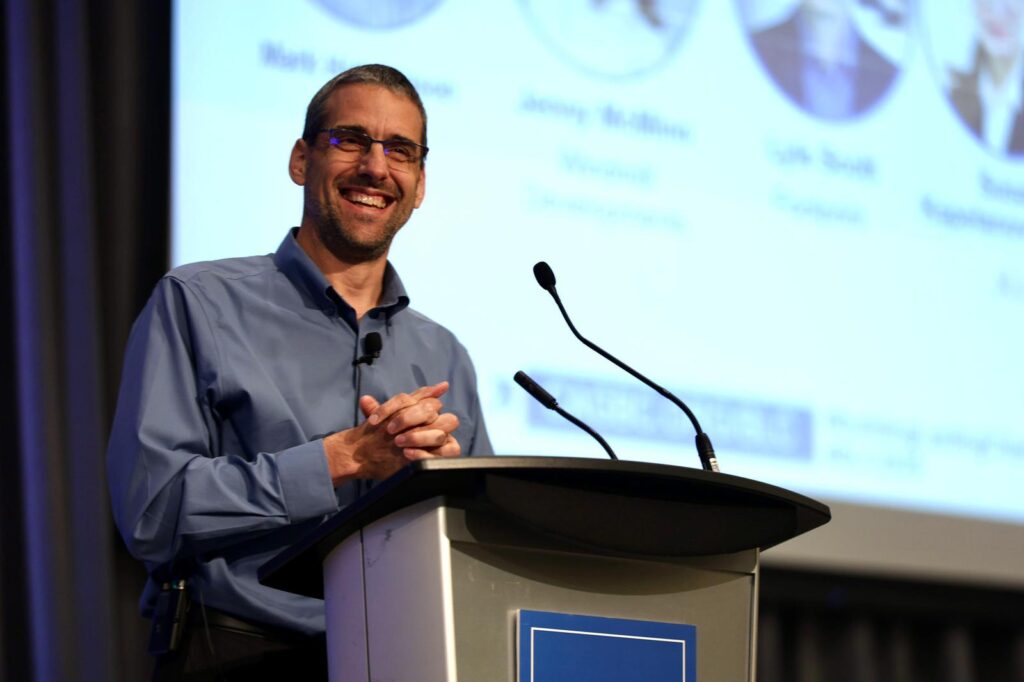Canada’s green building conference shines a spotlight on LEED v5
CAGBC Staff on July 2, 2025
- Theme
- Learn
Just a few weeks after the official launch of LEED v5, CAGBC’s Building Lasting Change™ (BLC) conference gave attendees an in-depth look at this much-anticipated version of the world’s most widely used green building rating system.
This year’s BLC program featured two sessions: one overview of how LEED v5 will drive impactful transformation across the built environment as well as a more technical deep dive into key credit updates. CAGBC Senior Vice President of Green Building Programs & Innovation Mark Hutchinson and Vice-President of USGBC President and CEO Peter Templeton shared the stage for opening remarks, stressing the importance of the unique long-standing collaboration between the two green building councils.
“CAGBC has benefited from a great partnership with USGBC, which has yielded tremendous advancements,” said Hutchinson. “The feedback we have received on LEED v5 is very positive and members of our community are very enthusiastic about the new possibilities it offers.”

Since its launch 25 years ago, LEED has profoundly impacted Canadian communities and has supported Canada’s efforts to transition to greener built environments. With over 6,000 buildings certified, Canada often ranks in the top five LEED territories globally and CAGBC members have and continue to play an important role in shaping and improving LEED. In fact, 500 comments were submitted by Canadian LEED practitioners during the LEED v5 comments period to help improve its future version’s applicability in a Canadian context.
A response to pressing challenges
As more organizations start investing in sustainability strategies, demand for voluntary standards will only increase. With that in mind, LEED v5 was developed to get more projects on board and capitalize on quick wins. The new version of LEED is a response to pressing challenges and the opportunities they present, from a sustainability and business perspective. Thanks to an updated scoresheet, a more holistic approach that focuses on decarbonization at all stages, a new development cycle, a built-in set of tools and resources to support project planning, this new version positions itself as a key enabler for achieving more sustainable, resilient, and high-value buildings.
“Tools and standards must shift with the market to stay relevant and create impact – LEED v5 does exactly that in the current context” said Templeton in the Green Building in Canada with LEED v5 session. “The goal is to define green building leadership for 2025 and beyond. Increasing LEED adoption will put us in a better position to close the gap between green project and green finance.”
By focusing on emerging impact areas such as decarbonization, human and ecological health, and resilience, LEED v5 carves new pathways to future-proof assets and higher investment potential.

Between focus and direction
LEED has been a crucial innovation driver in Canada over the past couple of decades. Panelists participating in both sessions echoed the general feeling about the new version taking a more upfront and holistic approach to decarbonize buildings, the system’s number one goal.
Unanimously, they highlighted LEED’s capacity to unify projects through a shared terminology and common pathways for comparable projects. As Footprint Principal Lyle explains, “LEED allows a common understanding across teams, but more importantly, it gives you focus and makes you pay attention to what matters most and not get too hung up on one aspect of the project.”
“LEED is a tool of choice on our projects,” said Adam Stoker, Senior Sustainable Infrastructure Engineer at City of Calgary. “It’s a fantastic tool that gets us to the starting line. It is so effective at setting goals that we even use it on projects not targeting certification. To put it shortly, we use LEED to make green building easy.”
The popularity of LEED is a key factor in its success among tenants too, with corporate ones prioritizing or even mandating it for leased spaces or new construction as LEED-certified assets are proven to drive return on investment and greater future earning potential. Susan Kapetanovic-Marr, Director of Climate and Decarbonization Practice Co-Lead at JLL North America says that through discussions with clients, “LEED has a brand name of a verifiable tool that occupiers prefer, and it’s increasing.” She added that “GRESB Investors and owners prioritize LEED in construction as it offers great tools that lay out a pathway and a methodology that everyone can follow.”
Certifying a building under the LEED rating system has become synonymous with sound investment, driving financial benefits for owners and occupants while promoting environmental sustainability. Under the new version, LEED-certified buildings will continue to command higher resale values, quality tenants, and lower operational costs due to increased energy and water efficiency.
New to LEED? Register now for our upcoming LEED Green Associate Exam Kickstarter, offered starting August 12.